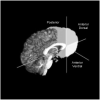Prefrontal cortex morphometry in abstinent adolescent marijuana users: subtle gender effects - PubMed (original) (raw)
Prefrontal cortex morphometry in abstinent adolescent marijuana users: subtle gender effects
Krista Lisdahl Medina et al. Addict Biol. 2009 Sep.
Abstract
Adult human studies suggest frontal dysfunction associated with chronic marijuana (MJ) use, but due to continued neuromaturation, adult studies may not generalize to adolescents. This study characterized prefrontal cortex (PFC) morphometry in chronic MJ-using adolescents following 1 month of monitored abstinence. Data were collected from MJ users (n = 16) and controls (n = 16) aged 16-18. Extensive exclusionary criteria included co-morbid psychiatric and neurologic disorders. Substance use and anatomical measures were collected after 28 days of monitored abstinence. PFC volumes were ascertained from manual tracing by reliable raters on high-resolution magnetic resonance images. After controlling for lifetime alcohol use, gender and intracranial volume, MJ users did not differ from controls in PFC volume. However, marginal group-by-gender interactions were observed (P < 0.09): female MJ users demonstrated comparatively larger PFC volumes while male MJ users had smaller volumes compared with same-gender controls. Further, group status and total PFC volume interacted in predicting executive functioning (P < 0.05). Among MJ users, smaller PFC total volume was associated with better executive functioning while the opposite pattern was seen among the controls. These preliminary results indicate that gender may moderate the relationship between MJ use and PFC morphometry. Given the relationship between larger PFC total volumes and poorer executive functioning among MJ users, female MJ users may be at increased risk for neurocognitive consequences. Future research will measure PFC gray and white matter separately and follow boys and girls over adolescence to examine the influence of MJ use on neurodevelopment.
Figures
Figure I
3D sagittal view of prefrontal cortex (PFC) boundary delineation.
Figure II
Total PFC volume/ICV by group and gender (multivariate interaction p<.09).
Figure III
Bivariate scatterplot between the total PFC volume/ICV and executive functioning composite score by group (multivariate interaction p<.05).
Similar articles
- Effects of marijuana use on prefrontal and parietal volumes and cognition in emerging adults.
Price JS, McQueeny T, Shollenbarger S, Browning EL, Wieser J, Lisdahl KM. Price JS, et al. Psychopharmacology (Berl). 2015 Aug;232(16):2939-50. doi: 10.1007/s00213-015-3931-0. Epub 2015 Apr 30. Psychopharmacology (Berl). 2015. PMID: 25921032 Free PMC article. - Abnormal cerebellar morphometry in abstinent adolescent marijuana users.
Medina KL, Nagel BJ, Tapert SF. Medina KL, et al. Psychiatry Res. 2010 May 30;182(2):152-9. doi: 10.1016/j.pscychresns.2009.12.004. Epub 2010 Apr 21. Psychiatry Res. 2010. PMID: 20413277 Free PMC article. - Neuropsychological functioning in adolescent marijuana users: subtle deficits detectable after a month of abstinence.
Medina KL, Hanson KL, Schweinsburg AD, Cohen-Zion M, Nagel BJ, Tapert SF. Medina KL, et al. J Int Neuropsychol Soc. 2007 Sep;13(5):807-20. doi: 10.1017/S1355617707071032. J Int Neuropsychol Soc. 2007. PMID: 17697412 Free PMC article. - Prefrontal cortex and executive functions in healthy adults: a meta-analysis of structural neuroimaging studies.
Yuan P, Raz N. Yuan P, et al. Neurosci Biobehav Rev. 2014 May;42:180-92. doi: 10.1016/j.neubiorev.2014.02.005. Epub 2014 Feb 23. Neurosci Biobehav Rev. 2014. PMID: 24568942 Free PMC article. Review. - The influence of marijuana use on neurocognitive functioning in adolescents.
Schweinsburg AD, Brown SA, Tapert SF. Schweinsburg AD, et al. Curr Drug Abuse Rev. 2008 Jan;1(1):99-111. doi: 10.2174/1874473710801010099. Curr Drug Abuse Rev. 2008. PMID: 19630709 Free PMC article. Review.
Cited by
- Effects of marijuana use on prefrontal and parietal volumes and cognition in emerging adults.
Price JS, McQueeny T, Shollenbarger S, Browning EL, Wieser J, Lisdahl KM. Price JS, et al. Psychopharmacology (Berl). 2015 Aug;232(16):2939-50. doi: 10.1007/s00213-015-3931-0. Epub 2015 Apr 30. Psychopharmacology (Berl). 2015. PMID: 25921032 Free PMC article. - Adolescent brain development, substance use, and psychotherapeutic change.
Wetherill R, Tapert SF. Wetherill R, et al. Psychol Addict Behav. 2013 Jun;27(2):393-402. doi: 10.1037/a0029111. Epub 2012 Jun 25. Psychol Addict Behav. 2013. PMID: 22732057 Free PMC article. Review. - Adolescent Substance Use and the Brain: Behavioral, Cognitive and Neuroimaging Correlates.
Hamidullah S, Thorpe HHA, Frie JA, Mccurdy RD, Khokhar JY. Hamidullah S, et al. Front Hum Neurosci. 2020 Aug 4;14:298. doi: 10.3389/fnhum.2020.00298. eCollection 2020. Front Hum Neurosci. 2020. PMID: 32848673 Free PMC article. - Neurotoxic effects of alcohol in adolescence.
Jacobus J, Tapert SF. Jacobus J, et al. Annu Rev Clin Psychol. 2013;9:703-21. doi: 10.1146/annurev-clinpsy-050212-185610. Epub 2012 Dec 10. Annu Rev Clin Psychol. 2013. PMID: 23245341 Free PMC article. Review. - Long-term effects of adolescent-onset and persistent use of cannabis.
Gonzalez R, Swanson JM. Gonzalez R, et al. Proc Natl Acad Sci U S A. 2012 Oct 2;109(40):15970-1. doi: 10.1073/pnas.1214124109. Epub 2012 Sep 24. Proc Natl Acad Sci U S A. 2012. PMID: 23012451 Free PMC article. No abstract available.
References
- Aasly J, Storsaeter O, Nilsen G, Smevik O, Rinck P. Minor structural brain changes in young drug abusers. A magnetic resonance study. Acta neurologica Scandinavica. 1993;87:210–4. - PubMed
- Amen DG, Waugh M. High resolution brain SPECT imaging of marijuana smokers with AD/HD. Journal of Psychoactive Drugs. 1998;30:209–14. - PubMed
- Benes FM, Turtle M, Khan Y, Farol P. Myelination of a key relay zone in the hippocampal formation occurs in the human brain during childhood, adolescence, and adulthood. Archives of General Psychiatry. 1994;51:477–84. - PubMed
Publication types
MeSH terms
Grants and funding
- 5T32 AA1352505/AA/NIAAA NIH HHS/United States
- 5P20 DA024194-020002/DA/NIDA NIH HHS/United States
- R01 AA013419/AA/NIAAA NIH HHS/United States
- R01 DA021182-03/DA/NIDA NIH HHS/United States
- F32 DA020206/DA/NIDA NIH HHS/United States
- 7K08 NS052147/NS/NINDS NIH HHS/United States
- 5R01 DA021182-03/DA/NIDA NIH HHS/United States
- 5R01 AA013419-07/AA/NIAAA NIH HHS/United States
- R01 DA021182/DA/NIDA NIH HHS/United States
- K08 NS052147/NS/NINDS NIH HHS/United States
LinkOut - more resources
Full Text Sources
Medical
Miscellaneous


